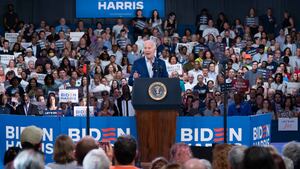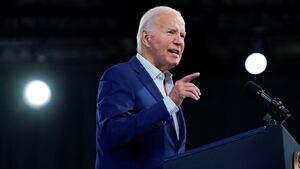From the moment Joe Biden walked (sort-of) on stage you sensed that this might not be his night.
After five minutes no-one was in any doubt. But should we be surprised? Thursday night’s catastrophe was the culmination of an abysmal campaign to date by Biden.
When Ezra Klein of The New York Times suggested, in February, that Biden should be replaced as the Democrats’ candidate he cited this as one key reason: “The presidency is a performance. You are not just making decisions, you are also acting out the things people want to believe about their president—that the president is in command, strong, energetic, compassionate, thoughtful, that… the president has it all under control.”
The Democratic establishment closed ranks around Biden and, weeks later, he pulled off a surprisingly agile and energetic State of the Union address. That laid to rest some of the fears raised in the Klein article.
But they soon resurfaced. And since that State of the Union address, Biden’s campaign has been marked by a mix of arrogance, stubbornness, and lethargy.
Biden and his senior team were all-too-relaxed about his sluggish polling in the first few months of this year. They felt certain that—once voters got a close-up of the former president in the months leading to the election—Donald Trump’s characteristic chaos and craziness would be his undoing.
And then there were Trump’s mounting legal difficulties. And the threat he posed to democracy. The Biden team made an assumption that this strategy would go a long way to securing victory in November. That Trump—and his record—would, in effect, defeat himself.
Meanwhile, Biden and his team were achingly slow to talk about some of the other issues that were animating voters: immigration, inflation, interest rates and housing. Biden didn’t need to shoulder the blame for huge numbers of people trying to enter the U.S., or for significant spikes in food costs. But he did need to show he cared, and that these were causing enormous anxiety. By the time Biden started to address immigration and “pocket-book” issues, it was too little. Perhaps it was also too late.
Voters have long since made up their mind about Trump, his threat to democracy and his “morals of an alley cat” (a huge insult to alley cats everywhere). Voters want Biden to talk about what matters to them in 2024 - not what mattered in 2016 or 2020.
The Biden team’s assumption that voters would get to see an unhinged, chaotic Trump in the months leading to the election—and would then be reminded of the ugliness of his last term—has proved wide of the mark.
The problem for Team Biden is that Trump, unlike in 2020, is not in the White House having his head melted by cable news, by COVID-19, by the fallout from the murder of George Floyd, or any of the Fox News talking points du jour which he lapped up from his TV room behind the Oval Office.
In the first debate of 2020 Biden bettered his low expectations. Trump, on the other hand, came out of that debate looking like a snarling, vicious,ugly, hot mess (one with COVID to boot.) On Thursday night Trump was calm, measured and collected. A liar? Sure. A crook? Absolutely. But he no longer looks like a man on the verge of a nervous breakdown.
This change of style and demeanor is likely down, in part, to the grown-ups surrounding Trump in his campaign team. The kids—in some cases literally—have left the building (Brad Pascale, Don Jnr., Jared and Ivanka) and he has a team of battle-hardened Republican campaign veterans running the show.
Probably the happiest people after the debacle—sorry, debate—were the “cheap fake” team at Republican election H.Q. They can take a lengthy July 4th holiday. Biden gifted his opponents enough real material to keep social media in overdrive for months.
It might be cheap, but unfortunately for Biden, it’s not fake.
John Mulholland is the former Editor of Guardian US and of The Observer in London.







